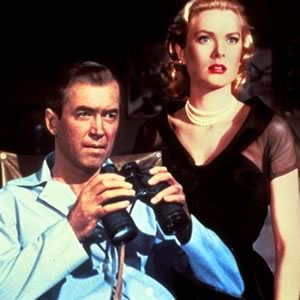Rear Window (Alfred Hitchcock, 1954): USA
Reviewed by Nathan Coleman. Viewed at the Mann Chinese Theater, AFI Fest Hollywood.
Rear Window is the 1954 motion picture directed by Alfred Hitchcock and is considered to be one of Hitchcock’s best and most thrilling works. The screenplay was written by John Micheal Hayes and is based on the short story “It Had to Be Murder” by Cornell Woolrich. Produced by Alfred Hitchcock and James C. Katz and edited by George Tomasini. It stars James Edward as L.B. Jefferies, and Grace Kelly as Lisa Carol Freemont.
After breaking his leg while on an assignment for the New York magazine, photographer L. B. “Jeff” Jefferies (James Stewart) spends his days in a wheelchair watching his neighbors through the window of his apartment. After a brief visit from his girlfriend Lisa Carol Fredmont (Grace Kelly), Jeff hears a woman scream and the sound of shattering glass, but sees nothing. Later that night, Jeff awakens in front of his window and sees the salesman leave his apartment across the courtyard with his suit case. Over the next few hours, Jeff observes the salesman coming and going with his case. Jeff suggests to Lisa that the salesman might have murdered his wife, but she dismisses his suspicions until she notices the salesman wrapping a rope around a large trunk. Jeff calls his friend Thomas J. Doyle, a police detective, and tells him about Thorwald. Doyle checks into it and later dismisses the idea by stating that witnesses saw Mrs. Thorwald leave that morning and board a train. Unconvinced, Jeff, Lisa, and his nurse Stella continue to look for evidence of foul play.
-Spoiler Alert-
They devise a plan to call Thorwald claiming they have evidence of his wife’s murder and tell him to meet at a hotel. While Thorwald is gone Lisa sneaks into his apartment and finds Mrs. Thorwald’s wedding ring, however, Thorwald returns home and catches her. They have a brief struggle until the police arrive and take her to jail while she still has the ring. Thorwald notices Jeff across the way and, after the police leave, goes over to his apartment. Unable to move, Jeff gets flash bulbs from his camera and attempts to blind Thorwald. The two fight until both fall out of the window. The police arrive on the scene and take Thorwald into custody where he confesses to the murder.
“Rear Window” is one of Alfred Hitchcock’s greatest works. Hitchcock uses only one set for the entire films narrative, yet he is able to bring everything to life. The set is brought to life as the misce-en-scene encompasses all the residents as they each go about their daily lives. Camera placement is ingeniously used to create suspense in the film. Instead of an omniscient point of view that the audience is usually offered, we are limited only to Jefferies point of view. The constant use of long shots across the court yard allows the audience to relate with the hero. This, in a way, creates an unusual sense of disquiet because Hitchcock allows our imagination to run wild with the endless possibilities of what might happen. The basis of the entire film satisfies the voyeuristic fantasy that is so prevalent in society. The male gaze could not be better defined than in this film. The viewer is given a hero with whom he can directly identify with. And it is through his point of view that we watch “Miss Torso” dance in her apartment. Even his girlfriend Lisa is shot in close up, with the camera panning over her entire body. The entire film revolves around the theme of voyeurism and the male gaze.
“Rear Window” will always be considered one of the most important films in American cinema history. Even now with mega blockbusters and the use of CGI and special effects, Hitchcock’s film is still renowned as an amazing work of art. It is a key example for anyone learning film studies, but should also be seen by anyone with an appreciation for the artistic genius.
About this entry
You’re currently reading “Rear Window (Alfred Hitchcock, 1954): USA,” an entry on Student Film Reviews
- Published:
- 11.15.10 / 2pm
- Category:
- AFI Filmfest 2010, Films

1 Comment
Jump to comment form | comments rss [?] | trackback uri [?]